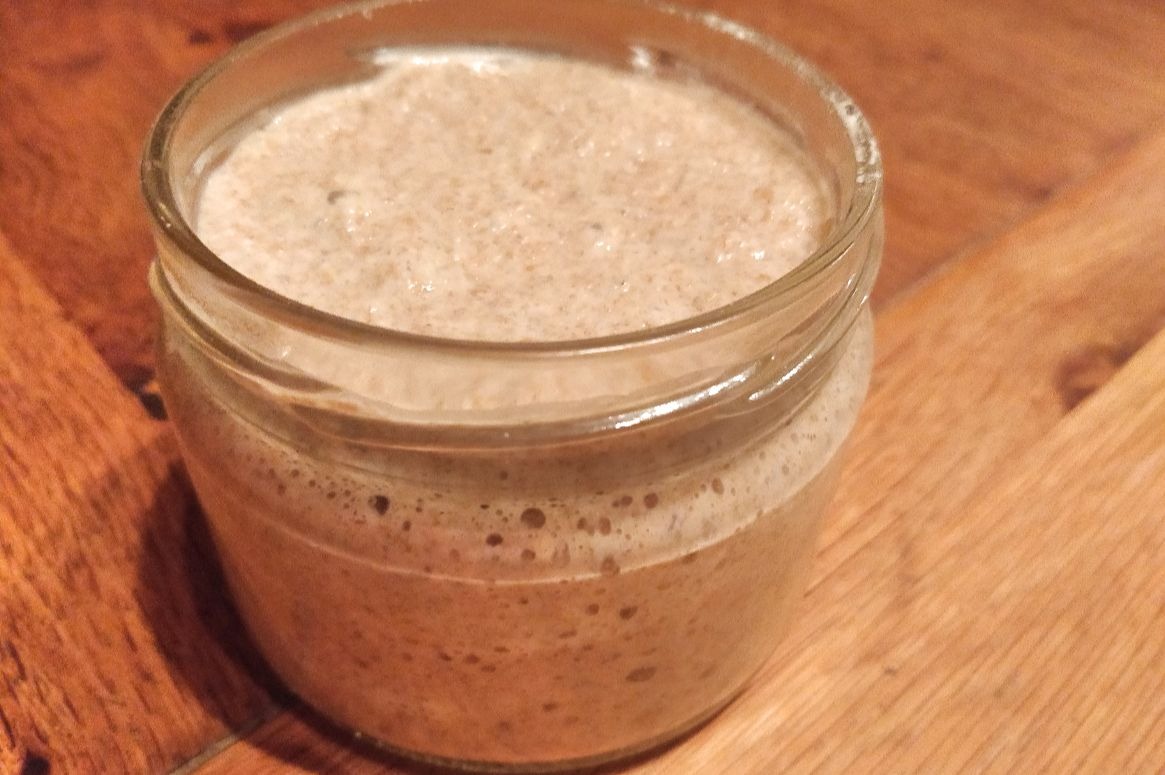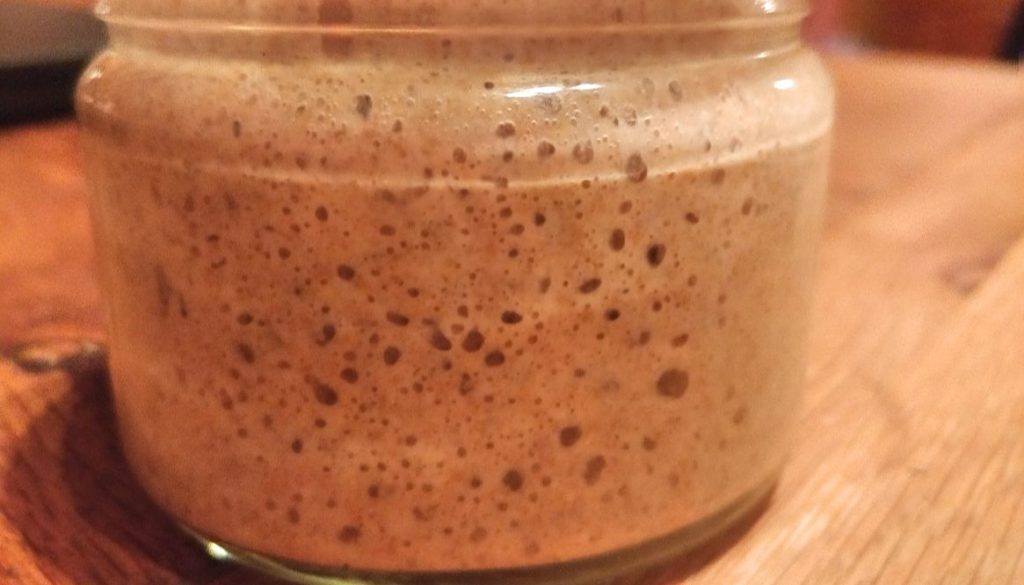Bread (I)– sourdough starter
It is definitely the hardest writing I’ve posted so far. How to describe something that has been so important part of humanity for the last 10,000 years?
To not to bore readers repeating historical facts that can be found in every history book, I try to approach this topic from a technological point of view and quote Harold McGee, who wrote in his book “On Food and Cooking, the science and lore of the kitchen“, that from the technology point of view the bread making has very simple stages: 1) mixing flour, water, salt and yeast (kneading) which results in 2) formation of the gluten network, 3) the yeast found in the dough produces carbon dioxide and generates fluffy mixture which 4) is baked, resulting in the characteristic structure and taste of the bread. Reality is a bit different and slightly more complex. Each step and component affects the result and being able to understand and control these stages, to select the components for making the bread and carry out the necessary processes, it is possible to achieve a wide variety of enjoyable flavors.
Taking account of all of these technological differences, components, we can still talk only a fraction of all the bread – only sour-dough bread.
Which components are important for making bread?
Flour.
Bread flour is, in the classic sense, always high in protein, allowing it to knead on a strong gluten network, and the bread made from them is fluffy, tasty and slightly chewy. Classically, bakers use wheat flour with a protein content of 11-12% to make bread.
Water.
Water has a significant effect on the bread structure. Acidic water weakens the gluten network, while the still alkaline still has the opposite effect. Ca and Mg.rich water condenses the structure of the dough. Approximately 40% of the water in the whole dough is considered to be the best volume ratio to obtain fluffy and elastic bread. In Italy, ciabatta is produced with a water content over 45%.
Salt.
Some bread are made without salt, although salt, in the right amount, is not perceptible to the taste of bread, but it also balances the taste. Approximately 1.5 to 2% of the weight of the used flour strengthens the gluten network. The salt also activates the proteolytic activity of yeasts, which on the contrary acts poorly on the proteins of the meal. The use of sea salt, with lots of Ca and Mg, makes the dough denser.
Yeast.
Yeast in traditional sweet pastry recipes in the range from 0.5 to 4% of the flour mass is used. At the same time, the bread, which is rising in the refrigerator overnight, 0.25% of yeast of the flour mass is used . The classic way to add yeast to the bread dough is to use pre-fermented sourdough starter. It has to be taken into account that the addition of the starter also adds to the dough a certain amount of flour, water and variety of bacteria and yeasts that live in a starter.
Sourdough starter
Sourdough starter is a combination of flour, water and symbiotic culture of yeast and Lactobacillus species. It is thought that the best sourdough starter can be prepared by itself. There is no need to ask a friend to keep some of the starter for you, to use yogurt, sour milk, breadcrumbs or other strange tricks. I tested the relatively long process of “creating” the starter described below, and I succeeded to get a well-functioning starter (that can be obtained from me if not willing to go through the full process of the starter make. Apparently, the first bread-maker makes the starter using the analog methodology.
Starter and the resulting bread flavor vary in different regions, and in hands of different bread makers which makes the taste of the bread from different sources and regions exciting experience. It is believed that the preparation of the sourdough bread is not easy, especially because the bacteria tend to “overgrow” from the starter culture, and too few yeasts in the starter produces less gas in the dough. “Healthy” starter is fluffy, bubbling, which is a sign of a decent amount of yeast cells in the starter. As much as I have read, one of the signs of a good starter is ability to rise least 100% of the initial amount due to the generated gases a couple of hours after the feeding of the starter. The rule of keeping the good and healthy root is that it should be frequent fed and aerated. The temperature could be in the range of 20-25 degrees, which promotes yeast but slows the growth of bacteria. In the case, if stored in a refrigerator, it is necessary to start restoring the maximum growth of the starter at least two or better three days before the bread making.
Preparation of the sourdough starter
Ingredients: water and flour, bigger, preferably a glass jar, scale to weigh the components (electronic weight would be ideal). Also, the relatively big amount of patience is needed.
Day 1. Mix 50 g of flour with 50 ml of water thoroughly, place the lid on the mixture so that air can be reached. Flour and microbes in the air and flour start to grow in the mixture. Keep your mixture in a warm place (20-25 degrees is the ideal temperature) for 24 hours. There is no change visible after the first day.
Day 2. Mix 50g of flour with 50ml of water and add 50ml of first day starter mix and keep for 24h in room temperature. At the end of the second day, some single bubbles can be seen on the surface of the mixture
Day 3. Repeat day 2 procedure, keep 24h in room temperature. By the end of the third day, on the walls of the jar, it is possible to see a few bubbles in a starter.
Day 4-5. Repeat the day 3 procedure, keep 24h in room temperature. At the end of the fourth and fifth days, the picture looks pretty much the same as at the end of the third day. I am lonely and silently start feeling a failure.
Day 6. Repeat the procedure described above. At the end of the sixth day, you can see that the starter have been rising upwards and there is many bubbles on the surface.
Day 7. Repeat the procedure described above. At the end of the seventh day, the starter starts to double in 2-3 hours after refreshing, and the starter have a characteristic smell of sour wine, bubbles lot and has become a semi-liquid with a foamy texture.

This is the point where it is possible to use the starter to make bread. It can also kept in refrigerator, but as I mentioned above, it is recommended at least 2, better than 3 days before the start of the bread making, to feed the starter and keep it warm. Always feed the starter according to the same strategy: 1/3 flour, 1/3 water, 1/3 root. To increase the amount of starter, do not throw away the excess but add the same amount of flour and water until the starter volume is sufficient to make the bread. You can also refresh the bread before every 12 hours before making the bread, which has a particularly good effect on the starter. Use the starter to make any bread that needs to be raised before baking.
Ready for baking!!!




